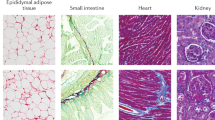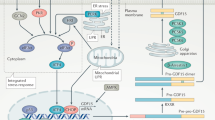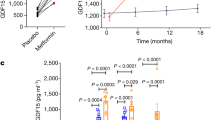Abstract
Insulin-like growth factor (IGF) 1 is a member of a family that is involved in growth, development, cell differentiation, and metabolism. IGF1, IGF2 and insulin act primarily through tyrosine-kinase-linked receptors—the IGF1 receptor (IGF1R) and insulin receptor (IR). The IGF1R binds IGF1 and IGF2 with high affinity and the IR binds insulin with high affinity; however, since both receptors share a high degree of structural and functional homology, the IGF1R can bind insulin and the IR can bind the IGFs with reduced affinity. These two receptors can, moreover, form heterodimers, which bind both ligands. Upon binding to the receptors, cascades of tyrosine and serine kinases are stimulated to facilitate growth or metabolism. The IGF2 receptor is a scavenger receptor, and is, therefore, not involved in mediation of growth or metabolic effects of the IGF family and will not be discussed in the current article. IGF1 is a major gene target of growth hormone and its product mediates many of the actions of growth hormone on growth and development; however, IGF1 has actions distinct from those of growth hormone in carbohydrate, lipid, and protein metabolism. For example, excess growth hormone causes insulin resistance and hyperglycemia, whereas IGF1 has insulin-like effects that reduce blood glucose levels and has been used experimentally to treat both type 1 and type 2 diabetes.
Key Points
-
The insulin-like growth factor 1 (IGF1) gene is a major target of growth hormone
-
IGF1 binds the IGF1 receptor (IGF1R) with high affinity and the insulin receptor with low affinity; conversely, insulin can bind IGF1R with lower affinity than it has for the insulin receptor
-
IGF1R and the insulin receptor can form heterodimers that bind both ligands
-
IGF1 has actions distinct from those of growth hormone in carbohydrate, lipid and protein metabolism; IGF1 can reduce blood glucose levels and has been used to treat patients with type 1 and 2 diabetes
This is a preview of subscription content, access via your institution
Access options
Subscribe to this journal
Receive 12 print issues and online access
$209.00 per year
only $17.42 per issue
Buy this article
- Purchase on Springer Link
- Instant access to full article PDF
Prices may be subject to local taxes which are calculated during checkout


Similar content being viewed by others
References
Firth SM and Baxter RC (2002) Cellular actions of the insulin-like growth factor binding proteins. Endocr Rev 23: 824–854
Monzavi R and Cohen P (2002) IGFs and IGFBPs: role in health and disease. Best Pract Res Clin Endocrinol Metab 16: 433–437
Dupont J and LeRoith D (2001) Insulin and insulin-like growth factor I receptors: similarities and differences in signal transduction. Horm Res 55 (Suppl 2): S22–S26
Lupu F et al. (2001) Roles of growth hormone and insulin-like growth factor 1 in mouse postnatal growth. Dev Biol 229: 141–162
Dominici FP et al. (2000) Compensatory alterations of insulin signal transduction in liver of growth hormone receptor knockout mice. J Endocrinol 166: 579–590
Coschigano KT et al. (2000) Assessment of growth parameters and life span of GHR/BP gene-disrupted mice. Endocrinology 141: 2608–2613
Liu JL et al. (2004) Disruption of growth hormone receptor gene causes diminished pancreatic islet size and increased insulin sensitivity in mice. Am J Physiol Endocrinol Metab 287: E405–E413
Guo Y et al. (2005) Pancreatic islet-specific expression of an insulin-like growth factor-I transgene compensates islet cell growth in growth hormone receptor gene deficient mice. Endocrinology 146: 2602–2609
Yakar S et al. (1999) Normal growth and development in the absence of hepatic insulin-like growth factor I. Proc Natl Acad Sci USA 96: 7324–7329
Yakar S et al. (2001) Liver-specific Igf-1 gene deletion leads to muscle insulin insensitivity. Diabetes 50: 1110–1118
Yakar S et al. (2004) Inhibition of growth hormone action improves insulin sensitivity in liver IGF-1-deficient mice. J Clin Invest 113: 96–105
Clemmons DR et al. (2005) Recombinant, nonglycosylated human insulin-like growth factor-binding protein-3 (IGFBP-3) is degraded preferentially after administration to type II diabetics, resulting in increased endogenous glycosylated IGFBP-3. J Clin Endocrinol Metab 90: 6561–6568
Haluzik M et al. (2003) Insulin resistance in the liver-specific IGF-1 gene-deleted mouse is abrogated by deletion of the acid-labile subunit of the IGF-binding protein-3 complex: relative roles of growth hormone and IGF-1 in insulin resistance. Diabetes 52: 2483–2489
Mauras N et al. (2000) Insulin-like growth factor I and growth hormone (GH) treatment in GH-deficient humans: differential effects on protein, glucose, lipid, and calcium metabolism. J Clin Endocrinol Metab 85: 1686–1694
Rose DR and Clemmons DR (2002) Growth hormone receptor antagonist improves insulin resistance in acromegaly. Growth Horm IGF Res 12: 418–424
Di Cola G et al. (1997) Hypoglycemic effect of insulin-like growth factor-1 in mice lacking insulin receptors. J Clin Invest 99: 2538–2544
Ranke MB (2005) Insulin-like growth factor-I treatment of growth disorders, diabetes mellitus and insulin resistance. Trends Endocrinol Metab 16: 190–197
Yuen K et al. (2004) Changes in free rather than total insulin-like growth factor-I enhance insulin sensitivity and suppress endogenous peak growth hormone (GH) release following short-term low-dose GH administration in young healthy adults. J Clin Endocrinol Metab 89: 3956–3964
Yuen K et al. (2002) The effects of short-term administration of two low doses versus the standard GH replacement dose on insulin sensitivity and fasting glucose levels in young healthy adults. J Clin Endocrinol Metab 87: 1989–1995
Johannsson G et al. (1997) Growth hormone treatment of abdominally obese men reduces abdominal fat mass, improves glucose and lipoprotein metabolism, and reduces diastolic blood pressure. J Clin Endocrinol Metab 82: 727–734
Jorgensen JO et al. (1994) Three years of growth hormone treatment in growth hormone-deficient adults: near normalization of body composition and physical performance. Eur J Endocrinol 130: 224–228
Bengtsson BA et al. (1993) Treatment of adults with growth hormone (GH) deficiency with recombinant human GH. J Clin Endocrinol Metab 76: 309–317
Kim KR et al. (1999) Low-dose growth hormone treatment with diet restriction accelerates body fat loss, exerts anabolic effect and improves growth hormone secretory dysfunction in obese adults. Horm Res 51: 78–84
Goodman HM (1968) Growth hormone and the metabolism of carbohydrate and lipid in adipose tissue. Ann N Y Acad Sci 148: 419–440
Raben MS and Hollenberg CH (1959) Effect of growth hormone on plasma fatty acids. J Clin Invest 38: 484–488
Richelsen B (1997) Action of growth hormone in adipose tissue. Horm Res 48 (Suppl 5): S105–S110
Rudling M et al. (1992) Importance of growth hormone for the induction of hepatic low density lipoprotein receptors. Proc Natl Acad Sci USA 89: 6983–6987
Oscarsson J et al. (1999) GH but not IGF-I or insulin increases lipoprotein lipase activity in muscle tissues of hypophysectomised rats. J Endocrinol 160: 247–255
Norrelund H et al. (2003) The decisive role of free fatty acids for protein conservation during fasting in humans with and without growth hormone. J Clin Endocrinol Metab 88: 4371–4378
Segerlantz M et al. (2001) Inhibition of the rise in FFA by acipimox partially prevents GH-induced insulin resistance in GH-deficient adults. J Clin Endocrinol Metab 86: 5813–5818
Zick Y (2004) Uncoupling insulin signalling by serine/threonine phosphorylation: a molecular basis for insulin resistance. Biochem Soc Trans 32: 812–816
Clemmons DR (2004) The relative roles of growth hormone and IGF-1 in controlling insulin sensitivity. J Clin Invest 113: 25–27
Heffernan M et al. (2001) The effects of human GH and its lipolytic fragment (AOD9604) on lipid metabolism following chronic treatment in obese mice and β(3)-AR knock-out mice. Endocrinology 142: 5182–5189
Hollenga C et al. (1991) Relationship between lipolysis and cyclic AMP generation mediated by atypical β-adrenoceptors in rat adipocytes. Br J Pharmacol 102: 577–580
Lafontan M and Berlan M (1993) Fat cell adrenergic receptors and the control of white and brown fat cell function. J Lipid Res 34: 1057–1091
Susulic VS et al. (1995) Targeted disruption of the β3-adrenergic receptor gene. J Biol Chem 270: 29483–29492
Rudman D et al. (1990) Effects of human growth hormone in men over 60 years old. N Engl J Med 323: 1–6
Taaffe DR et al. (1994) Regional fat distribution by dual-energy X-ray absorptiometry: comparison with anthropometry and application in a clinical trial of growth hormone and exercise. Clin Sci (Lond) 87: 581–586
Taaffe DR et al. (2001) Recombinant human growth hormone, but not insulin-like growth factor-I, enhances central fat loss in postmenopausal women undergoing a diet and exercise program. Horm Metab Res 33: 156–162
Scavo LM et al. (2004) Insulin-like growth factor-I stimulates both cell growth and lipogenesis during differentiation of human mesenchymal stem cells into adipocytes. J Clin Endocrinol Metab 89: 3543–3553
Huang Y et al. (2004) Physical and functional interaction of growth hormone and insulin-like growth factor-I signaling elements. Mol Endocrinol 18: 1471–1485
Zizola CF et al. (2002) Changes in IGF-I receptor and IGF-I mRNA during differentiation of 3T3-L1 preadipocytes. Biochimie 84: 975–980
Albert SG and Mooradian AD (2004) Low-dose recombinant human growth hormone as adjuvant therapy to lifestyle modifications in the management of obesity. J Clin Endocrinol Metab 89: 695–701
Franco C et al. (2005) Growth hormone treatment reduces abdominal visceral fat in postmenopausal women with abdominal obesity: a 12-month placebo-controlled trial. J Clin Endocrinol Metab 90: 1466–1474
Horber FF and Haymond MW (1990) Human growth hormone prevents the protein catabolic side effects of prednisone in humans. J Clin Invest 86: 265–272
Mauras N and Haymond MW (2005) Are the metabolic effects of GH and IGF-I separable? Growth Horm IGF Res 15: 19–27
Fryburg DA and Barrett EJ (1999) Physiological effects and potential applications of GH and IGF-I. Diabetes Nutr Metab 12: 329–336
Turkalj I et al. (1992) Effect of increasing doses of recombinant human insulin-like growth factor-I on glucose, lipid, and leucine metabolism in man. J Clin Endocrinol Metab 75: 1186–1191
Louard RJ et al. (1992) Insulin sensitivity of protein and glucose metabolism in human forearm skeletal muscle. J Clin Invest 90: 2348–2354
Biolo G et al. (1995) Physiologic hyperinsulinemia stimulates protein synthesis and enhances transport of selected amino acids in human skeletal muscle. J Clin Invest 95: 811–819
Wilmore DW (1999) The use of growth hormone in severely ill patients. Adv Surg 33: 261–274
Mulligan K et al. (1999) Use of growth hormone and other anabolic agents in AIDS wasting. JPEN J Parenter Enteral Nutr 23 (Suppl 6): S202–S209
Haffner D et al. (2000) Effect of growth hormone treatment on the adult height of children with chronic renal failure. German Study Group for Growth Hormone Treatment in Chronic Renal Failure. N Engl J Med 343: 923–930
Mauras N et al. (2002) Growth hormone has anabolic effects in glucocorticosteroid-dependent children with inflammatory bowel disease: a pilot study. Metabolism 51: 127–135
Takala J et al. (1999) Increased mortality associated with growth hormone treatment in critically ill adults. N Engl J Med 341: 785–792
Clemmons DR (1993) Use of growth hormone and insulin-like growth factor I in catabolism that is induced by negative energy balance. Horm Res 40: 62–67
Mauras N (1995) Combined recombinant human growth hormone and recombinant human insulin-like growth factor I: lack of synergy on whole body protein anabolism in normally fed subjects. J Clin Endocrinol Metab 80: 2633–2637
Mulligan K and Schambelan M (2002) Anabolic treatment with GH, IGF-I, or anabolic steroids in patients with HIV-associated wasting. Int J Cardiol 85: 151–159
Frost RA et al. (1996) Wasting in the acquired immune deficiency syndrome is associated with multiple defects in the serum insulin-like growth factor system. Clin Endocrinol (Oxf) 44: 501–514
Unterman TG (1993) Insulin-like growth factor binding protein-1: identification, purification, and regulation in fetal and adult life. Adv Exp Med Biol 343: 215–226
Arslanian SA et al. (1993) Insulin therapy increases low plasma growth hormone binding protein in children with new-onset type 1 diabetes. Diabet Med 10: 833–838
Press M et al. (1984) Importance of raised growth hormone levels in mediating the metabolic derangements of diabetes. N Engl J Med 310: 810–815
Baxter RC (1995) Insulin-like growth factor binding proteins as glucoregulators. Metabolism 44: 12–17
Hussain MA et al. (1993) Insulin-like growth factor I stimulates lipid oxidation, reduces protein oxidation, and enhances insulin sensitivity in humans. J Clin Invest 92: 2249–2256
Rennert NJ et al. (1993) Metabolic effects of rhIGF-1 in normal human subjects. Adv Exp Med Biol 343: 311–318
Clemmons DR et al. (2000) The combination of insulin-like growth factor I and insulin-like growth factor-binding protein-3 reduces insulin requirements in insulin-dependent type 1 diabetes: evidence for in vivo biological activity. J Clin Endocrinol Metab 85: 1518–1524
Acerini CL et al. (1998) Effects of low-dose recombinant human insulin-like growth factor-I on insulin sensitivity, growth hormone and glucagon levels in young adults with insulin-dependent diabetes mellitus. Metabolism 47: 1481–1489
Morrow LA et al. (1994) Recombinant human insulin-like growth factor-I therapy improves glycemic control and insulin action in the type A syndrome of severe insulin resistance. J Clin Endocrinol Metab 79: 205–210
Moses AC et al. (1996) Recombinant human insulin-like growth factor I increases insulin sensitivity and improves glycemic control in type II diabetes. Diabetes 45: 91–100
Zenobi PD et al. (1992) Effects of insulin-like growth factor-I on glucose tolerance, insulin levels, and insulin secretion. J Clin Invest 89: 1908–1913
Author information
Authors and Affiliations
Corresponding author
Ethics declarations
Competing interests
The authors declare no competing financial interests.
Rights and permissions
About this article
Cite this article
LeRoith, D., Yakar, S. Mechanisms of Disease: metabolic effects of growth hormone and insulin-like growth factor 1. Nat Rev Endocrinol 3, 302–310 (2007). https://doi.org/10.1038/ncpendmet0427
Received:
Accepted:
Issue Date:
DOI: https://doi.org/10.1038/ncpendmet0427
This article is cited by
-
Evaluating the effect of recombinant human growth hormone treatment on sleep-related breathing disorders in toddlers with Prader–Willi syndrome: a one-year retrospective cohort study
BMC Pediatrics (2024)
-
Inverse association between adult height and diabetes risk in a cohort study of Chinese population
Scientific Reports (2023)
-
Resveratrol and Dulaglutide ameliorate adiposity and liver dysfunction in rats with diet-induced metabolic syndrome: Role of SIRT-1 / adipokines / PPARγ and IGF-1
DARU Journal of Pharmaceutical Sciences (2023)
-
Serum biomarkers of colonic polyps in patients with acromegaly: a meta-analysis and systematic review
Pituitary (2023)
-
IGF-1 is positively associated with BMI in patients with acromegaly
Pituitary (2023)



